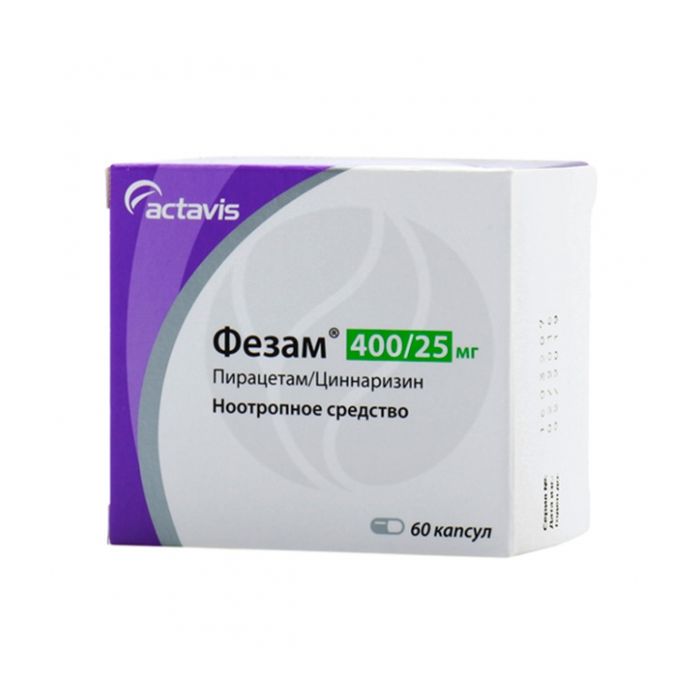Fezam capsules 400mg + 25mg, No. 60
Expiration Date: 05/2027
Russian Pharmacy name:
Фезам капсулы 400мг + 25мг, №60
Insufficiency of cerebral circulation (atherosclerosis of the vessels of the brain, the recovery period of ischemic and hemorrhagic strokes, craniocerebral trauma, encephalopathy of various origins), intoxication;
other diseases of the central nervous system, accompanied by a decrease in intellectual and mnestic functions (impaired memory, attention, mood), psychoorganic syndrome with a predominance of signs of asthenia and adynamia, asthenic syndrome;
labyrinthopathies, Meniere's syndrome;
lag in intellectual development in children, prevention of migraine and kinetosis.
Inside.
The usual adult dose is 1-2 capsules three times a day for 6 for 1-3 months, depending on the severity of the disease.
The course of treatment is 2-3 times a year.
Children (over 5 years old) - 1-2 capsules 1-2 times a day.
Do not use for more than 3 months.
1 capsule contains as active substances - piracetam 400 mg, cinnarizine 25 mg.
Excipients - lactose, colloidal silicon dioxide, magnesium stearate.
The capsule shell contains titanium dioxide, gelatin.
Individual intolerance,
severe impairment of liver and / or kidney function,
parkinsonism,
pregnancy,
lactation,
children under 5 years old.
Carefully: Parkinson's disease.
Trade (proprietary) name of the drug: fezamЃ / PhezamЃ
Dosage form:
Capsules
Composition:
1 capsule contains as active substances - piracetam 400 mg, cinnarizine 25 mg.
Excipients - lactose, colloidal silicon dioxide, magnesium stearate.
The capsule shell contains titanium dioxide, gelatin.
Description:
Capsules - hard, cylindrical white gelatin capsules, No. 0.
The contents of the capsules are a powdery mixture, from white to almost white, conglomerates are allowed, which, when pressed with a glass rod, easily turn into powder.
Pharmacotherapeutic group:
Nootropic agent.
ATX code: N06BX
Pharmachologic effect:
pharmacodynamics:
Combined drug with a pronounced antihypoxic, nootropic and vasodilating effect.
Piracetam activates metabolic processes in the brain by enhancing energy and protein metabolism, accelerating the utilization of glucose by cells and increasing their resistance to hypoxia; improves interneuronal transmission in the central nervous system, improves regional blood flow in the ischemic zone.
Cinnarizine- a selective blocker of slow calcium channels, inhibits the entry of calcium ions into cells and reduces their content in the plasmolemma depot, reduces the tone of smooth muscles of arterioles, reduces their response to biogenic vasoconstrictor substances (epinephrine, norepinephrine, dopamine, angiotensin, vasopressin). It has a vasodilating effect (especially in relation to cerebral vessels, enhancing the antihypoxic effect of piracetam), without significantly affecting blood pressure. Shows moderate antihistamine activity, reduces the excitability of the vestibular apparatus, lowers the tone of the sympathetic nervous system. Increases the elasticity of erythrocyte membranes, their ability to deform, reduces blood viscosity.
Pharmacokinetics:
The drug is rapidly and completely absorbed in the gastrointestinal tract. The maximum concentration of piracetam in plasma is created after 2-6 hours. The maximum concentration in the cerebrospinal fluid is after 2-8 hours. Bioavailability is 100%. It does not bind to plasma proteins. Penetrates into all organs and tissues, passes the placental barrier. Selectively accumulates in the cerebral cortex, mainly in the frontal, parietal and occipital lobes, cerebellum and basal ganglia. Not metabolized. After 30 hours, more than 95% is excreted by the kidneys.
The maximum concentration of cinnarizine in plasma is created in 1-4 hours. It binds to plasma proteins by 91%. It is actively and completely metabolized. The half-life is 4 hours. 1/3 of metabolites is excreted in the urine, 2/3 - in feces.
Indications for use:
Insufficiency of cerebral circulation (atherosclerosis of the vessels of the brain, the recovery period of ischemic and hemorrhagic strokes, craniocerebral trauma, encephalopathy of various origins), intoxication;
other diseases of the central nervous system, accompanied by a decrease in intellectual and mnestic functions (impaired memory, attention, mood), psychoorganic syndrome with a predominance of signs of asthenia and adynamia, asthenic syndrome;
labyrinthopathies, Meniere's syndrome;
lag in intellectual development in children, prevention of migraine and kinetosis.
Contraindications:
Individual intolerance,
severe impairment of liver and / or kidney function,
parkinsonism,
pregnancy,
lactation,
children under 5 years old.
Carefully: Parkinson's disease.
Method of administration and dosage:
Inside.
The usual adult dose is 1-2 capsules three times a day for 6 for 1-3 months, depending on the severity of the disease.
The course of treatment is 2-3 times a year.
Children (over 5 years old) - 1-2 capsules 1-2 times a day.
Do not use for more than 3 months.
Side effect:
Dyspepsia, headache, sleep disturbances. Rarely - allergic reactions in the form of a skin rash.
Interaction with other medicinal products:
With the simultaneous administration, it is possible to enhance the sedative effect of drugs that depress the activity of the central nervous system, as well as alcohol, nootropic and antihypertensive drugs. Vasodilators enhance the effect of the drug. Improves the tolerance of antipsychotic drugs and tricyclic antidepressants.
Special instructions:
The drug should be administered with caution to persons with liver and / or kidney disease. In cases of mild to moderate renal failure (especially if creatinine clearance is less than 60 ml / min), the therapeutic dose should be reduced or the intervals between doses should be increased. In persons with impaired liver function, it is necessary to control the content of liver enzymes.
Drinking alcohol should be avoided during treatment.
The drug should be used with caution in Parkinson's disease.
The drug can cause the appearance of a positive reaction in the control of doping drugs in athletes.
Driving cars and a robot with mechanisms.
During treatment, care should be taken when driving and working with machines and equipment.
Release form:
Capsules (400 mg + 25 mg), 10 capsules in a blister, 6 blisters with instructions for use in a cardboard box.
Storage conditions:
Store in a dark, dry place at a temperature of 15-25 ? C.
Keep out of the reach of children!
Shelf life:
3 years.
Do not use after the expiration date printed on the package.
Terms of dispensing from pharmacies:
On prescription.

